1. Greater freedom of head movement
Get unstuck from a fixed head position
When using a conventional stereo microscope, users must severely limit any head movements, otherwise the exit pupils become misaligned and the magnified image is not seen clearly.
Due to the expanded exit pupil, eyepiece-less microscopes liberate users from a fixed head position. Operators can move their head from side to side relieving any strain or tension build up from a fixed head position, especially when users are using microscopes for an extended period of time.
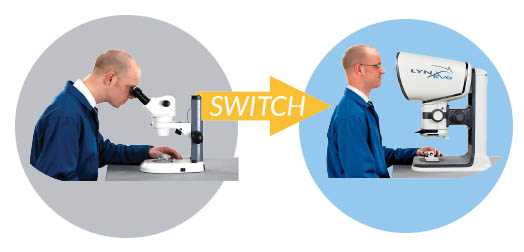
2. Maintain a comfortable body position
Improve productivity with enhanced user comfort
Microscopy can make tough demands on an operator’s skeletal system. When operators are uncomfortable or strained, accuracy and performance is compromised.
Conventional microscope operators must maintain an unnatural, fixed body position to keep their eyes in position with the eyepieces. Holding a position for lengthy periods of time causes body fatigue and can cause long-term neck and back problems, and more.
A research study* documenting the effects of long term microscope use found 78% of conventional microscope operators suffered from neck strains. This is due to maintaining a slight incline of the head, such as 30 degrees from vertical, which can produce significant muscle contractions, fatigue, and pain.
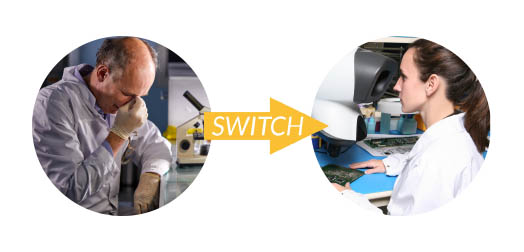
3. Manipulate objects without losing focus
Improved hand to eye co-ordination and manipulation of objects
Hand-eye coordination is always a challenge when using tools or when manipulating subjects under an ordinary microscope. When working with traditional microscopes, hand to eye co-ordination is sometimes difficult because the short distance between the eye and the eyepiece limits peripheral vision.
Operators that use an eyepiece-less system can sit further back from the microscope, allowing much greater peripheral vision and therefore improving the ability to use hands and tools in a safer and more intuitive manner.
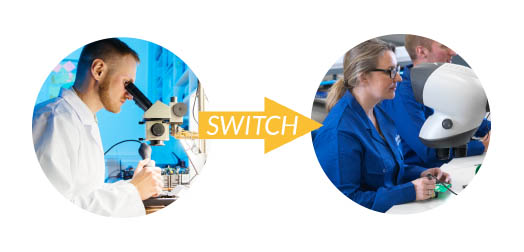
4. Reduce eye strain and headaches
Reduces eyestrain
94% of microscope users reported visual problems or a combination, of eye discomfort including headaches and dry eyes. There are 3 main reasons why so many microscope users experience this form of discomfort
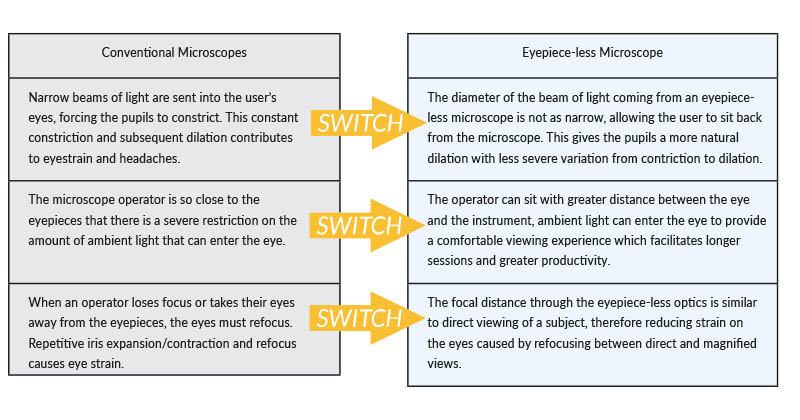
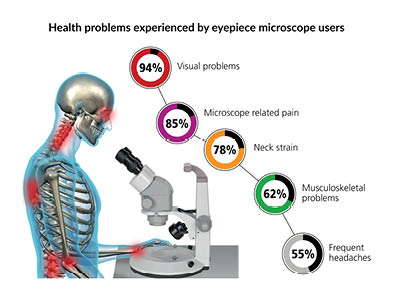
Statistic Sources:
1. Thompson SK, Mason E, Dukes S. Ergonomics and cytotechnologists: reported musculoskeletal discomfort. Diagn Cytopathol. 2003;29:364–367.
2. Garima Jain and Pushparaja Shetty Occupational concerns associated with regular use of microscope: International Journal of occupational Medicine and environmental Health 2014;27(4):591–598.
3. Fritzsche et al.; licensee BioMed Central Ltd. 2012
5. Wear glasses/safety goggles
Eye-relief and how it affects operators who need to wear eyewear
Eyewear users may experience difficulty using microscope eyepieces to achieve a
clear unimpeded view. This is because each eye needs to be at the point in front of the eyepiece where the image is formed. This point is the ‘exit pupil’ and is typically between 3mm to 5mm in diameter, not much bigger than the size of pupils in daylight. A clear viewing position is achieved when the exit pupil completely covers the pupil of the eye and is held there without difficulty. Most microscope users need to be in direct contact with microscope eyepieces in order maintain the correct viewing position and to keep the image in sight.
Problems arise for glasses wearers when their eyes cannot get close enough to the exit pupil. When this happens the image is in focus but the field of view is restricted and it is difficult to keep the exit pupil over (or within) the eye pupil diameter. In addition, a slight shift in user position can cause shadowing in the field of view.
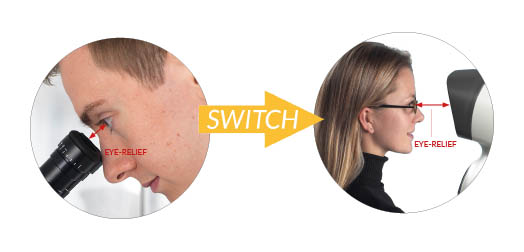
Eye-relief is the distance an operator needs to be at in order to align the exit pupils with their own pupils. The smaller the exit pupil the less distance there is in order to clearly see an image. Operators who need to wear glasses, require a minimum eye relief area around 18mm – 20mm in order to accommodate for the glasses.
Eyepiece-less microscopes increases the exit pupil diameter up to 38mm. The greater the eye-relief the more space there is for glasses or protective goggles.
6. Reduction in cross contamination
Employees’ health and safety as a priority
Today more companies are putting the health and safety of their employees as a priority. There are significant health benefits associated with eyepiece-less microscopes compared with eyepiece microscopes. As well as their ergonomic advantages, eyepiece- less stereo microscopes present clear advantages for minimizing cross contamination: the viewer’s eyes are not in contact with the instrument, greatly reducing the risk of infection from shared use, and wearing protective goggles or face shields does not restrict their usability.
Ideal for environments where microscopes are shared among users, eyepiece-less microsystems need minimal adjustments and are virtually contact-less which keeps employees safe in the workplace without interrupting the inspection process and productivity.
Since eyepiece-less microscopes have an increased eye-relief distance, they can be used in laminar flow cabinets when working with particle sensitive materials to prevent contamination.
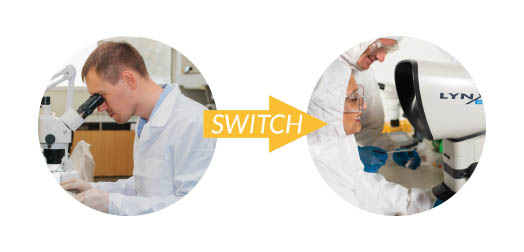
7. A cost effective solution
Factoring in true cost of ownership
When considering a stereo microscope, technological advances, such as optics, magnification, lighting and ergonomics will most likely influence your decision. Something else to consider are the benefits of a high quality microscope and how buying one of lesser quality can adversely affect time and costs.
Poor quality is expensive. Typically a company will have losses due to waste, rework and warranties at an average of 10%. If quality standards do not improve, it could cost manufacturers their reputation.
Company losses can also take place when production deadlines are not met due to poor quality of supply chain materials or when production is delayed due to employee health.
Because workers must keep their eyes fixed for long periods of time, they often experience eye strain, headaches and eye fatigue requiring them to take multiple relief breaks, which takes time away from production. Eyepiece-less microscopes offer an ideal solution offering enhanced user comfort which may result in increased production and productivity.
Overlooking the “true cost” of a less expensive inspection microscope may be more expensive in the long run. It’s not necessary to buy more bells and whistles than you need, however, it is important to think ahead and consider how your business may change and grow, as well as about less tangible things, such as the cost to repair your reputation if you do not deliver quality results.




